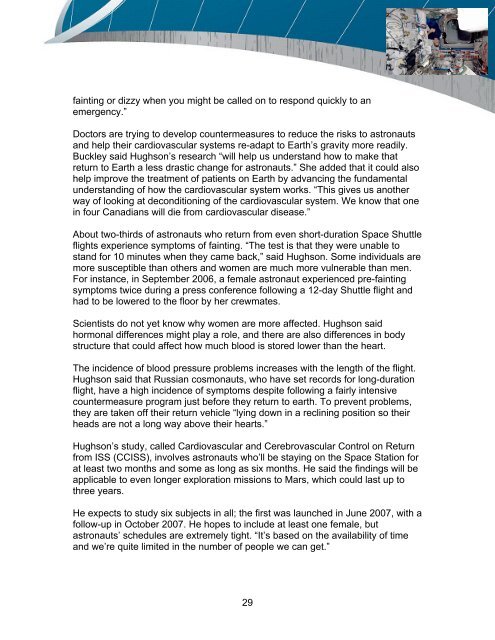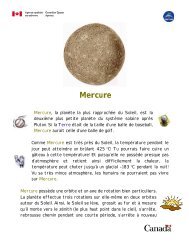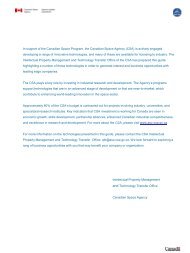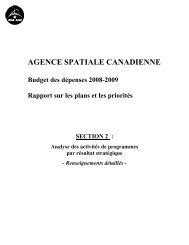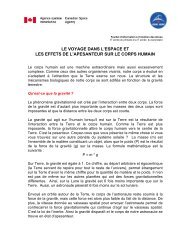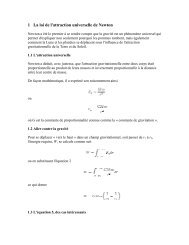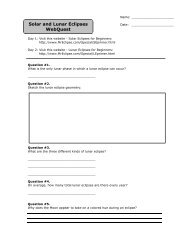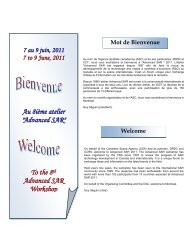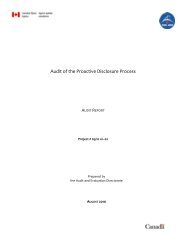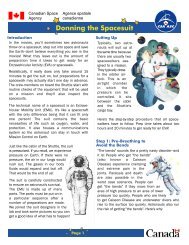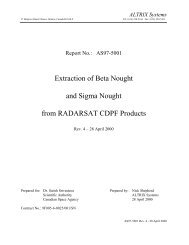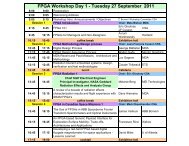PDF version of COSPAR - Space Science Research in Canada Report
PDF version of COSPAR - Space Science Research in Canada Report
PDF version of COSPAR - Space Science Research in Canada Report
You also want an ePaper? Increase the reach of your titles
YUMPU automatically turns print PDFs into web optimized ePapers that Google loves.
fa<strong>in</strong>t<strong>in</strong>g or dizzy when you might be called on to respond quickly to anemergency.”Doctors are try<strong>in</strong>g to develop countermeasures to reduce the risks to astronautsand help their cardiovascular systems re-adapt to Earth’s gravity more readily.Buckley said Hughson’s research “will help us understand how to make thatreturn to Earth a less drastic change for astronauts.” She added that it could alsohelp improve the treatment <strong>of</strong> patients on Earth by advanc<strong>in</strong>g the fundamentalunderstand<strong>in</strong>g <strong>of</strong> how the cardiovascular system works. “This gives us anotherway <strong>of</strong> look<strong>in</strong>g at decondition<strong>in</strong>g <strong>of</strong> the cardiovascular system. We know that one<strong>in</strong> four Canadians will die from cardiovascular disease.”About two-thirds <strong>of</strong> astronauts who return from even short-duration <strong>Space</strong> Shuttleflights experience symptoms <strong>of</strong> fa<strong>in</strong>t<strong>in</strong>g. “The test is that they were unable tostand for 10 m<strong>in</strong>utes when they came back,” said Hughson. Some <strong>in</strong>dividuals aremore susceptible than others and women are much more vulnerable than men.For <strong>in</strong>stance, <strong>in</strong> September 2006, a female astronaut experienced pre-fa<strong>in</strong>t<strong>in</strong>gsymptoms twice dur<strong>in</strong>g a press conference follow<strong>in</strong>g a 12-day Shuttle flight andhad to be lowered to the floor by her crewmates.Scientists do not yet know why women are more affected. Hughson saidhormonal differences might play a role, and there are also differences <strong>in</strong> bodystructure that could affect how much blood is stored lower than the heart.The <strong>in</strong>cidence <strong>of</strong> blood pressure problems <strong>in</strong>creases with the length <strong>of</strong> the flight.Hughson said that Russian cosmonauts, who have set records for long-durationflight, have a high <strong>in</strong>cidence <strong>of</strong> symptoms despite follow<strong>in</strong>g a fairly <strong>in</strong>tensivecountermeasure program just before they return to earth. To prevent problems,they are taken <strong>of</strong>f their return vehicle “ly<strong>in</strong>g down <strong>in</strong> a recl<strong>in</strong><strong>in</strong>g position so theirheads are not a long way above their hearts.”Hughson’s study, called Cardiovascular and Cerebrovascular Control on Returnfrom ISS (CCISS), <strong>in</strong>volves astronauts who’ll be stay<strong>in</strong>g on the <strong>Space</strong> Station forat least two months and some as long as six months. He said the f<strong>in</strong>d<strong>in</strong>gs will beapplicable to even longer exploration missions to Mars, which could last up tothree years.He expects to study six subjects <strong>in</strong> all; the first was launched <strong>in</strong> June 2007, with afollow-up <strong>in</strong> October 2007. He hopes to <strong>in</strong>clude at least one female, butastronauts’ schedules are extremely tight. “It’s based on the availability <strong>of</strong> timeand we’re quite limited <strong>in</strong> the number <strong>of</strong> people we can get.”29


